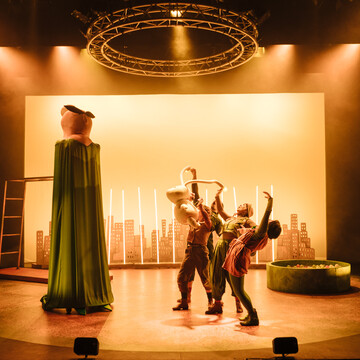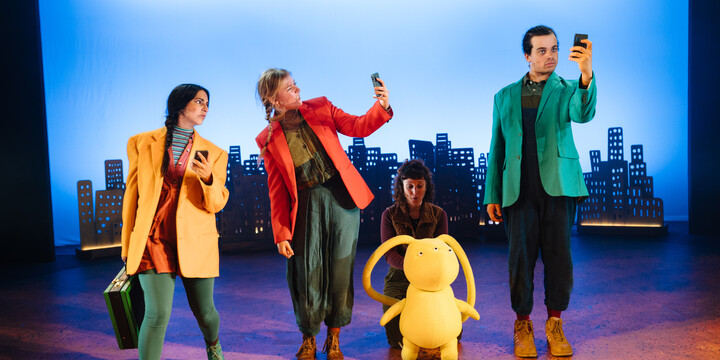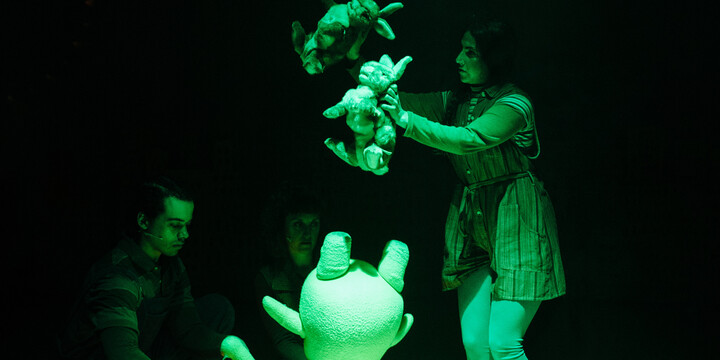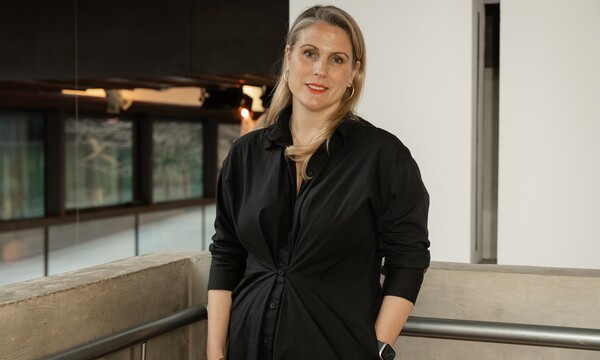News Story

1. What drew you to adapt Beegu for the stage, and how did you approach staying true to Alexis Deacon’s original story while bringing your own creative vision to it?
When the Unicorn’s brilliant Artistic Director, Rachel Bagshaw, gave me the book to read, I immediately connected to Beegu. She’s a particularly compelling character - Alexis Deacon has made her both an otherworldly alien, but also totally familiar and lovable. She’s plucky, curious and brave but also feels different and lost. It felt like the book spoke to so many examples of being different in some way and not quite finding your way of fitting in, and then conversely the joy and affirmation of finding the people that get you. The illustration is also incredible - I’m quite a visually-lead theatre maker, and Alexis’ art style is so beautiful that it very quickly inspired myriad ways to bring it to the stage. It’s also fairly sparse text wise, and that felt like an opportunity to go in depth into the world of Beegu and give all the brilliant characters a voice.
Staying true to the story came primarily from making sure we kept the emotional journey of Beegu, and the message the same - I took the same truths that Alexis so elegantly portrays, and asked, how can they show up in a theatrical way on stage? It’s a very different experience to reading - reading or being read to has an intimacy and a different sense of time, where you can move at your own pace. In the theatre with 300 kids around you, it’s immediate and requires a different energy. Knowing this, I stuck true to Beegu’s journey, and tried to express her experience meeting earthlings.
I also kept as many of Alexis’ words from the book as possible - the prose narration, for instance, became the words of the Sun and Moon, who are part narrators and part Beegu’s guardians throughout.
For me, adaptation from one medium to another is about keeping the heart of the original piece, whilst maximising the new form that you’re bringing. So something like how Beegu speaks - which in the book is a series of symbols - brings questions like, what sounds does she use? What pitch is her voice? How much of her language do we recognise, if anything? How do we make it the most impactful on stage, and the most true to the origin of the book? This involves a lot of playing around and trying things. It’s such a genius book I wanted to stay as close to it as possible. I essentially took each page, and used every detail on it as inspiration for a scene. Even the first pages before the title of the book, which is a night sky covered in stars, became our preset before the show starts, though this time with some music and a snoozey moon.
I also did an R&D with some fantastic actors who devised some sections as well as working on the script and the characterisation - their imaginations are weaved throughout this too.
2. In terms of creating a world for young audiences, how do you ensure that the themes of friendship, inclusion, and respect resonate with children in such a visually and emotionally engaging way?
One of the glorious things about making a show at the Unicorn is the Creative Hub. This is the dept of the theatre that connects the work to young people - they ran weeks of workshops with local schools about the book before I even began. So I was massively inspired by the children’s responses - they spoke about how you welcome someone new to the area (you show them around, you use kind words, you learn a bit of their language), what it feels like to be different, and also about that horrible moment when you lose your mum in the supermarket. I used how the young people expressed these emotions when making the play so it would truly connect with that age group. Then they invited children into rehearsals so we could get feedback on the material, and see what connected most with our audience. It’s an age group that understands friendship and inclusion on a deep level, so they really get it.
A big part of making the themes resonate was Beegu herself - Jonathan Saville designed the Beegu puppet, and made her a distinct character with a lovable face and such brilliant, long, dynamic ears. Her expressiveness was then amplified even more by her excellent puppeteer, Emma MacLennan, who also voiced her, and made her a relatable, complex, warm and wonderful creature.

3. With Beegu being a story about an alien who feels disconnected from Earth, how do you approach the challenge of making a character from another world relatable to young children?
Honestly, that wasn’t a big challenge - young children have such committed and expansive imaginations that they can very quickly see themselves in a character, even if she is an alien. Beegu is much more like them than any of the adults are - yes, she has three eyes, but she’s got a big personality, is around their height, is constantly navigating grumpy adults who are too busy scrolling on their phones, is desperate to play and have fun, has a cheeky sense of humour and a strong sense of justice. Which is very like our audience.
A lot of our young audience also have experiences of being different, be it nationality, neurodivergence, disability, ethnicity, you name it - so they get what Beegu’s going through.
4. Can you tell us more about your collaboration with the creative team, particularly with Jean Chan, Laura Cubitt, and the puppetry design team? How did each element help shape the world of Beegu?
I was really lucky to work with an excellent creative team. Jean is a brilliant designer who’s worked at the Unicorn before and always creates whole, distinct worlds on stage. Her commitment to keeping the essence of the book really paid off - it’s a beautiful set, with gorgeous costumes in a specific palette that create an atmosphere. It’s a set that had to take us from outer space with a spaceship crash, through the countryside into an inner city playground, and Jean achieved all that with dexterity and creativity, and still looking and feeling like the book. We have a moving set piece of a city scape, and it’s almost exactly the same as the city scape as on page 5, except big and on wheels!
She had previously collaborated with our puppet designer, Jonathan, and so we brought him on board. Jonathan usually designs for Spitting Image, which is obviously wildly different to Beegu, but he completely understood what we needed and collaborated with us throughout rehearsals to shape her to what we needed. I’m particularly excited that he made my idea of her having light up ears actually work.
Laura Cubitt is a titan in the field of puppetry. She not only shaped the technical side of puppetry and movement across the whole show, but she was a master of character, emotion and storytelling. She worked every part of the Beegu puppet to let us in on Beegu’s thoughts and feelings. I had never worked with puppets before, and Laura’s knowledge and expertise was invaluable. She was in rehearsal several days every week - she was truly my co-pilot making this show, and the cast and I couldn’t value her more.
Deanna Choi’s sound and music also gives both heart and energy to the production in such a detailed, epic, bold way - her storytelling is unrivalled. Will Monks video and lighting design is so dynamic and vibrant - he took inspiration from the book, and then met the story of each scene and added magic.

5. What kind of atmosphere or mood do you hope to create for the younger audience members, and how do you balance humor with the more heartfelt moments of the story?
We hope to make a space which feels playful, welcoming and encourages everyone to be boldly themselves. There’s a lot of silliness and madcap energy in the show - there are some puppies who have some tricks to show off - but also some moments of thoughtfulness, where we take a breath to really let how important friendship is land.
I also wanted to really lean into the joy of being all together as a massive group - that’s a really special part of a being at the theatre. It’s in front of you, live, it can’t stop, and it matters that you’re there. A lot of the most exciting moments of the show really play on that - there’s even a dance moment you can join in with, in a big collective moment of joy. Our audience should very much feel like they’re part of the world.
I also wanted to create lots of moments of kindness and love, be that Beegu and her parents, acts of friendship, pets, passing moments of the kindness of strangers, or even the way nature looks after us.
Balancing humour and the heartfelt has been integral from the start. The book does this so gracefully, in a way that feels respectful to young people’s intelligence and emotional life, and we took inspiration from that - for every upsetting moment Beegu faces (at once point she’s shouted at by a horrible man) there is a moment of light (she’s welcomed by the kids in the playground who try to speak her language). This strange and wonderful mix of things feels quite close to real life.
6. What’s one thing you hope children will take away from watching Beegu, whether it's a lesson, a feeling, or just a special moment they remember?
I’d love them to take away how important acts of friendship are, be it playing, giving gifts, or standing up for someone.
There’s also quite a fun bit where Beegu transforms everything in the school playground with her alien powers, and it’s entertaining but also shows how when you welcome someone in they can show you new ways to look at things.
I also hope that get to see how children can often have a better idea of how to treat people with kindness and welcome them in, than adults do. Sometimes adults have built up weird ideas about the world and its rules and who matters and who doesn’t, and as Beegu finds out, it’s the young people who get it right.
7. If Beegu could visit your home, what do you think she would find most surprising or interesting about Earth?
Maybe the Scottish accents? I joke!
I think she’d find people fascinating, and all the differences in how they look, sound, think and act. People can be so complicated and so simple, and are sometimes awful and sometimes delightful, and I think Beegu would see that the beauty of all that is that it all exists at once, sometimes in the same person. I think she’d also love nature - everything from bright, blooming flowers to dried out, dead trees are incredible in their own way. Imagine encountering a butterfly as an alien? Or a sloth?
And she’d definitely enjoy a chocolate biscuit.




